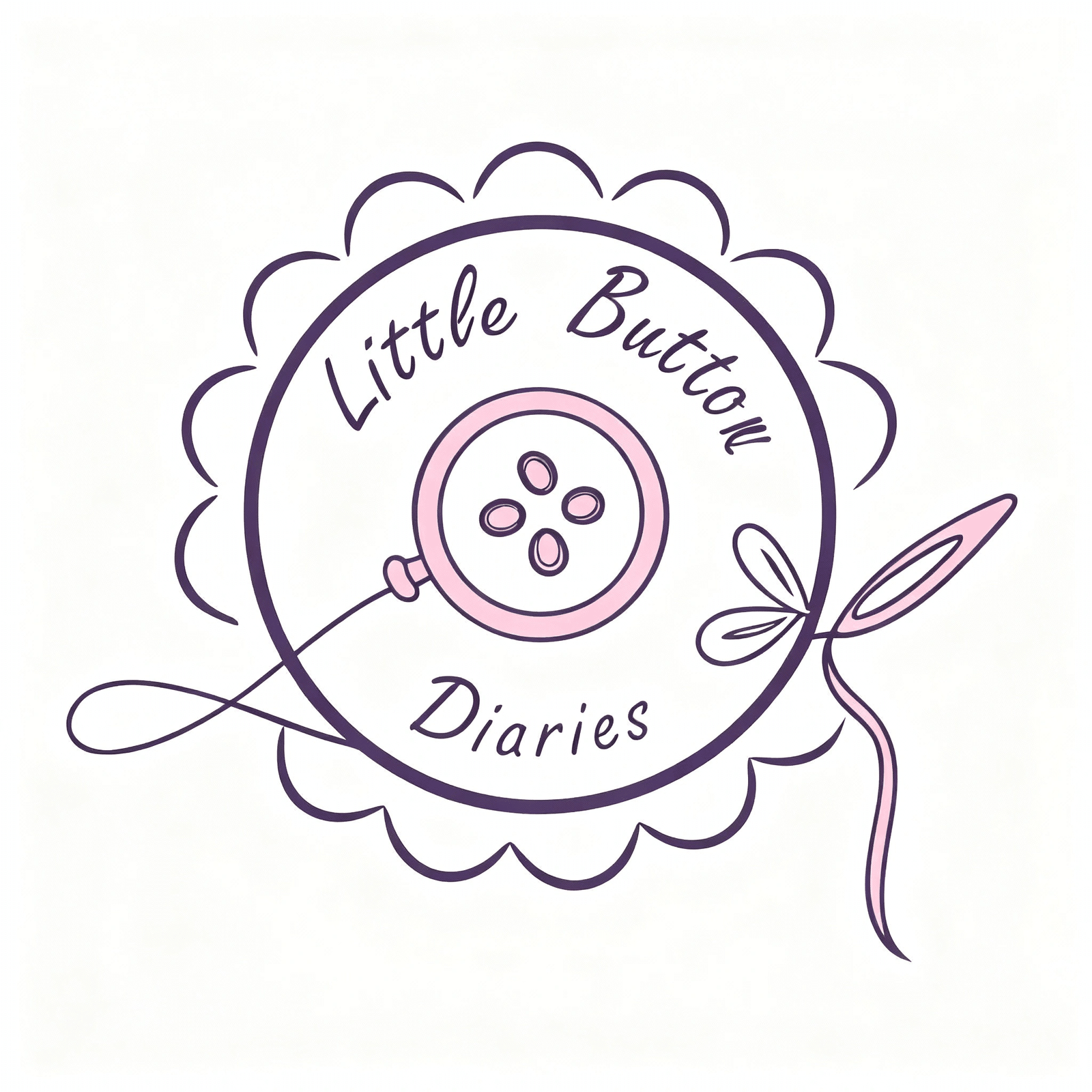Want to create an enchanting fairy garden in your outdoor space? This article shares the best fairies garden ideas, including essential supplies, unique containers, perfect plants, and fun DIY projects. Get ready to transform your garden into a magical retreat!
Key Takeaways
- Start your fairy garden with essential supplies like miniatures and plants, and look for deals at craft stores and online.
- Get creative with unique containers for your garden, such as repurposed teacups or birdbaths, while ensuring they have proper drainage.
- Encourage kids to participate in fairy gardening to bond as a family and teach them about nature through imaginative play.
- Essential Fairy Garden Supplies
- Creative Fairy Garden Containers
- DIY Fairy House Ideas
- Choosing the Perfect Plants
- Adding Fairy Garden Accessories
- Creating Miniature Pathways
- Incorporating Water Features
- Seasonal Fairy Garden Maintenance
- Inspiring Fairy Village Themes
- Engaging Kids in Fairy Gardening
- Summary
- Frequently Asked Questions
Essential Fairy Garden Supplies
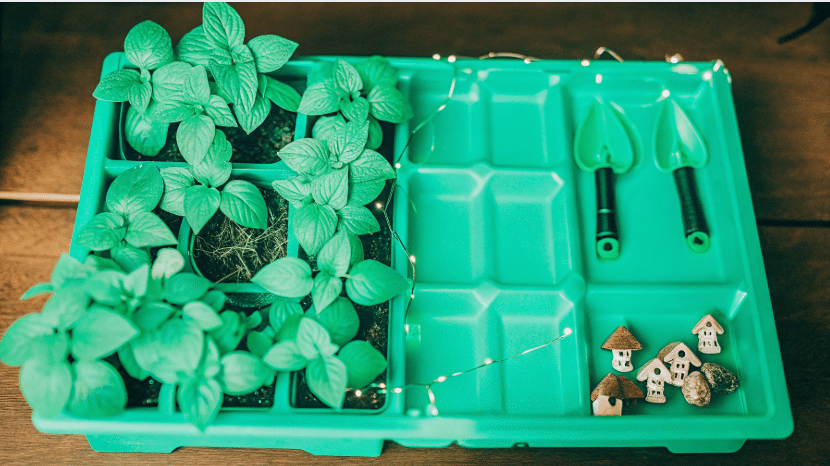
Gathering essential supplies is the first step into the world of fairy gardens. Miniature garden accessories, fairy houses, and small plants are the basics. You can find these items in craft stores like Joann’s, Michael’s, and Hobby Lobby, as well as garden centers and online retailers such as Amazon. The Dollar Tree also offers affordable options for tiny fairies and accessories.
Reading reviews when shopping for fairy garden accessories online ensures quality purchases. Watching for sales at stores like Hobby Lobby can also help you get good deals. With these supplies, you’re set to create an enchanting fairy garden.
Remember, the beauty of fairy gardens lies in the details. From handmade items to store-bought miniatures, the right supplies will help you make a fairy garden come to life and make it a truly magical space.
Creative Fairy Garden Containers
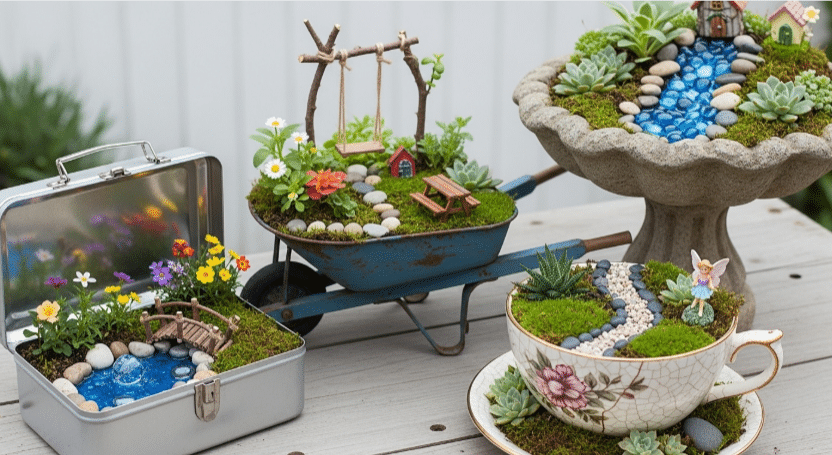
Selecting a larger container for your fairy garden is an exciting part of the process. Creative options include:
- tea cups
- Lunchboxes
- Old wheelbarrows
- Birdbaths
These repurposed items add unique charm and are eco-friendly, giving new life to objects that might otherwise be discarded.
When designing larger containers for fairy gardens, consider the following:
- Use more plants and invest in additional supplies.
- Ensure your containers have drainage holes to avoid water build-up, which can harm your plants.
- Pick containers with good drainage and the appropriate size to help maintain the health and beauty of your fairy garden.
Whether you opt for a repurposed birdbath or a tiny teacup, the container you choose sets the stage for your fairy garden. Let your imagination run wild and pick something that adds a touch of whimsy and creativity to your outdoor space.
DIY Fairy House Ideas
Making DIY fairy houses is a fun and rewarding project, adding a personal touch to your garden. One popular idea is transforming a birdhouse with decorative elements like clay flowers and tiny wind chimes. For a whimsical fall design, pumpkins or gourds can serve as fairy houses.
Using natural materials, you can create temporary fairy houses without glue:
- Sticks, leaves, and rocks as basic materials
- Popsicle sticks to provide a sturdy base
- Twigs and moss to embellish for a rustic look
- A tree stump repurposed by cutting out a simple door to serve as a fairy house
For those who love recycling, plastic soda bottles can be transformed into fairy houses adorned with shells and jewels for a magical appearance. Twig and moss can also be combined to create delicate fairy houses with a natural aesthetic. Concrete fairy houses can be made from converted birdhouses with polymer clay doors and birch bark roofs.
Unconventional items like:
- birdhouses
- teacups
- broken clay pots allow for varied designs and add a unique touch to your fairy garden. These DIY fairy house ideas not only make your garden more enchanting but also provide a creative outlet for crafting and recycling. Choose materials and designs that speak to your style and let your fairy garden come to life with whimsy and charm.
Choosing the Perfect Plants
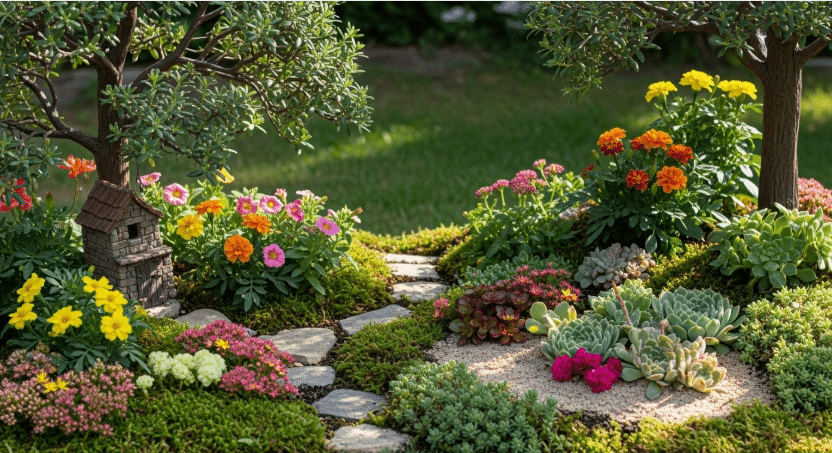
Choosing the right plants is crucial for your fairy garden’s success. For sunny gardens, consider these options:
- Marigolds and petunias: easy to grow and require minimal care
- Sedum and moss roses: great choices for sunny, dry gardens
- Succulent plants and sedums: thrive well in arid climates, adding a touch of greenery
If your garden has more shade, choosing plants suited for less sunny spots will help maintain a vibrant fairy garden. When selecting plants, consider:
- Choosing plants suited for less sunny spots if your garden has more shade.
- Considering their growth habits to prevent overcrowding.
- Opting for regular small plants instead of ‘fairy garden miniatures’ for healthier growth.
Pruning keeps your fairy garden plants small and manageable. Regularly cleaning plants and décor with a soft brush or cloth maintains their enchanting appearance. In spring, refresh your fairy garden by replacing dead plants and checking for winter damage.
During summer, ensure your garden receives morning sun and afternoon shade to prevent overheating. In autumn, reduce watering and prepare the garden for cold weather by possibly moving it indoors. For winter protection, cover your garden with frost cloth or move it indoors to prevent frost damage.
By carefully choosing and maintaining your plants, your fairy garden will thrive and continue to enchant throughout the seasons with planting.
Adding Fairy Garden Accessories
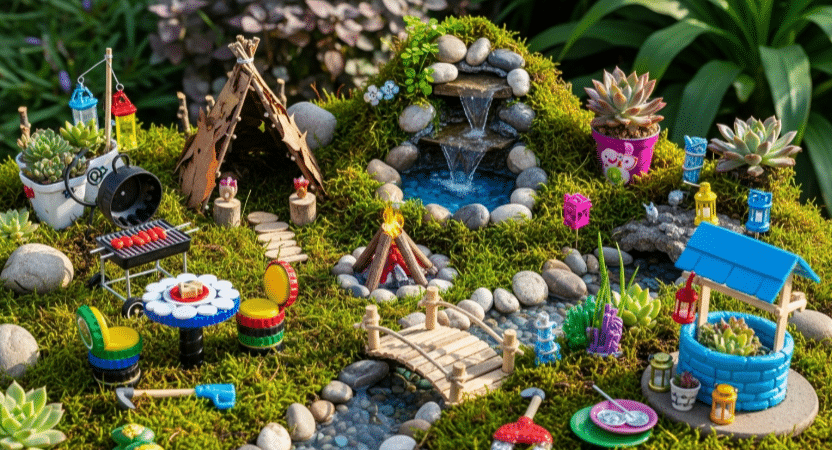
Fairy garden accessories complete your magical space with fairy furniture. Here are some great starting points:
- Budget-friendly kits or individual pieces
- A DIY mini barbecue to add a whimsical touch
- Fairy chairs and tables made from bottle caps, offering customizable and creative options
A DIY miniature terrarium waterfall can add a magical touch to your setup. Simple fairy tents and campgrounds can be made with materials found around the house. Upcycled plastic water bottles can be transformed into delightful fairy garden wells. Craft a plastic cup fairy bridge using recycled containers and craft sticks for added charm. Explore some DIY fairy garden ideas to enhance your creativity.
To add an extra touch of enchantment to your garden, consider the following more ideas:
- Place small plants or mini succulent pots around a fairy wishing well.
- Incorporate decorative elements like tiny dishes, foods, and kitchen accessories for authenticity.
- Add polymer clay lanterns with tiny string lights for glowing accents.
- Create a cute banner in the garden to communicate whimsical messages.
These accessories not only enhance the visual appeal of your fairy garden but also allow you to express your creativity and decorate your garden truly unique, creating a figure of your imagination.
Creating Miniature Pathways
Miniature pathways are a charming addition to any fairy garden. Materials such as pea gravel, aquarium stones, and larger stones can be used to create appealing pathways. Woodland themes can incorporate natural materials like bark and moss to create an immersive environment.
To secure small rocks in your fairy garden, mix clay-heavy dirt with water to create an effective adhesive. Marbles or small pebbles can also be used creatively for pathways leading to focal points such as wishing wells.
These pathways not only guide the fairies through your garden in so many ways but also add texture and interest to your miniature landscape.
Incorporating Water Features
Adding water features to your fairy garden can create a magical ambiance. You can create a fairy garden pond using a mirror, Mod Podge, and glitter to simulate reflective water. A galvanized container with floating candles makes an enchanting pond centerpiece.
A hot glue waterfall can be fashioned from recycled plastic, hot glue, rocks, and moss to create a flowing effect. Pebbles and glass beads can create the illusion of a sparkling water surface. These water features are particularly suitable for special occasions like evening outdoor weddings and summer garden parties.
Adding water features brings a magical touch, along with tranquility and beauty, to your fairy garden.
Seasonal Fairy Garden Maintenance
Seasonal maintenance is crucial for keeping your fairy garden looking its best. Regular tasks include watering, trimming plants, and protecting accessories. Ensure fairy garden plants, especially those in containers, are well-watered to maintain their vitality.
Here are some great tips to maintain your plants and outdoor features:
- If plants start looking shaggy, give them a haircut or trim to maintain a neat appearance.
- Use silicone sealant instead of hot glue to enhance the durability of outdoor fairy houses against the elements.
- Seal pathways with a protective coating to enhance their durability.
Monitor for pests and use natural remedies like neem oil to protect the delicate ecosystem. By following these maintenance tips, your fairy garden will continue to enchant and delight throughout the year.
Inspiring Fairy Village Themes
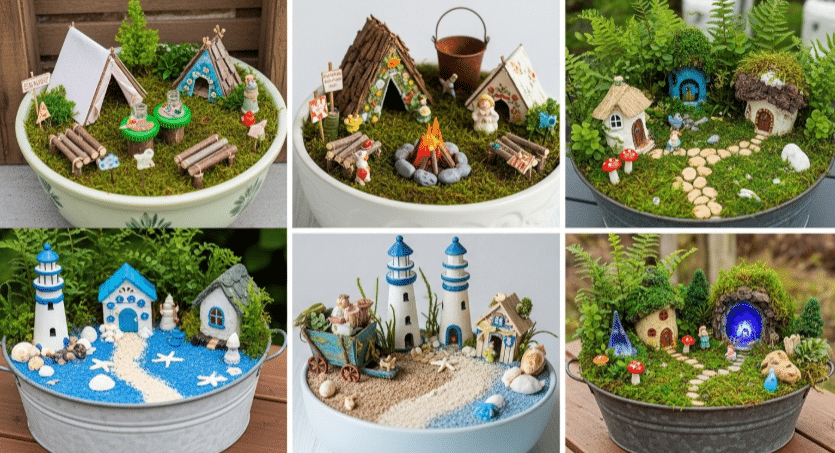
A themed fairy village can add an extra layer of magic to your yard garden. Unique themes include camping and vintage, using upcycled items. A coastal theme with handmade accessories can bring a touch of the seaside to your garden.
An enchanted forest theme can be represented through lush greenery and magical elements. Color schemes can be tailored to the chosen theme, using soft pastels for a whimsical look or vibrant colors for a lively atmosphere. Upcycled containers can significantly enhance the charm of your fairy garden.
By choosing a theme, you can create a super easy cohesive and enchanting fairy village that sparks the imagination with inspiration and creative ideas.
Engaging Kids in Fairy Gardening
Engaging kids in fairy gardening is a great way to get them outdoors and entertained. Fairy gardens draw children into gardening and help them understand nature. Crafting fairy garden accessories can be a calming and enjoyable family activity.
Kids can have fun searching for components to create furniture and décor for their fairy garden. Making DIY fairy garden accessories is imaginative and has therapeutic benefits for kids. Children also learn conflict resolution skills by sharing the fairy garden space and negotiating how to use it together.
By involving kids in fairy gardening, you can create lasting memories and a beautiful garden with little plants.
Summary
Creating a fairy garden is a magical and rewarding experience. By following the tips and ideas in this guide, you can gather the right supplies, choose the perfect plants, and add enchanting accessories to bring your fairy garden to life. Maintenance and seasonal care will ensure your garden continues to thrive and delight throughout the year.
Whether you’re creating a fairy garden on your own or involving kids in the process, the possibilities are endless. Let your imagination run wild and create a magical outdoor space that will captivate everyone who sees it.
Frequently Asked Questions
Where can I find fairy garden supplies?
You can snag fairy garden supplies at craft stores like Joann’s, Michael’s, and Hobby Lobby, as well as at garden centers and online on sites like Amazon. Don’t forget to check out The Dollar Tree for some budget-friendly finds!
What are some creative containers for a fairy garden?
You can use fun stuff like teacups, lunchboxes, and even old wheelbarrows for your fairy garden. It’s all about getting creative with what you have and adding a personal touch!
How do I choose the right plants for my fairy garden?
To pick the right plants for your fairy garden, match them to the sunlight in your space—go for marigolds and petunias in sunny spots, or select shade-tolerant varieties for darker areas. Happy gardening!
What are some DIY fairy house ideas?
You can get creative with fairy houses by turning birdhouses into magical dwellings, using pumpkins or gourds, or constructing them from sticks and rocks found in your backyard. It’s all about letting your imagination run wild with natural materials!
How can I engage kids in fairy gardening?
Get kids involved by letting them create mini accessories or search for natural elements to add to the garden. It’s a great way for them to learn about nature while having fun!
